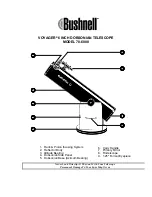
15
K. FREQUENTLY ASKED QUESTIONS:
1) How far can I see?
If you stand outside and look up at the night sky on a clear evening, you can see
hundreds of stars without the aid of your telescope. The telescope is a light-gathering
instrument that magnifies the view—providing significantly more detail and unveiling
more stars, nebulae, and celestial objects. With the aid of a telescope, you will be able
to enjoy exciting views of Saturn’s rings, Jupiter’s major moons, the Orion Nebula, and
much more.
2) Why can’t I see anything through my telescope?
If you see only gray or black when looking through your telescope, even after searching
for an object to view, it is very likely that you are using an eyepiece that is too powerful.
To solve this problem always start with the lowest power eyepiece at first, and only
insert the higher-power eyepiece after you have located an object.
3) When I use my high-power eyepiece, everything looks much darker. Why?
As magnification in a telescope increases, brightness diminishes. Conversely,
brightness increases when magnification is reduced. If an image appears too dark or
unclear, use a lower-powered eyepiece. Views of small, bright objects are superior to
those of large, dark, or blurry ones! Atmospheric conditions, air currents, as well as light
and air pollution also affect viewing quality.
4) As I look through my telescope, why do objects in the sky appear to move?
The constant rotation of the Earth makes things appear to move. Lower-power
eyepieces will reduce this effect of movement considerably and allow you to observe an
object for a longer duration before you have to readjust your telescope.
6) Whom do I contact for more information and product questions?
For any inquiries, parts, warranty or service information, please contact:
Phone:
800-441-1100
212-947-7100
e-mail:
or
Visit our website at www.colemanoptics.com


























